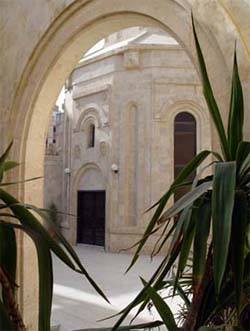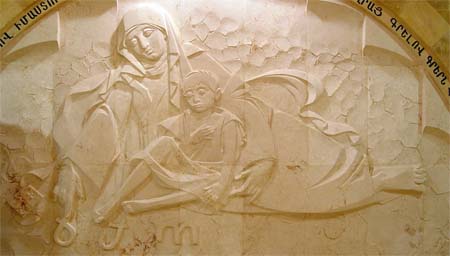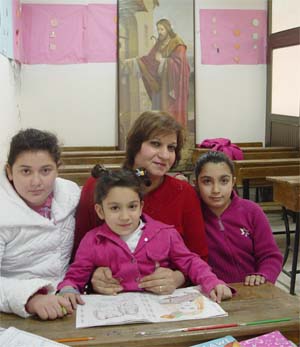
I make my through the quiet bus depot toward the street where I am soon surrounded by seven or eight eager taxi drivers. Once they realise that I am a foreign visitor, I can almost see the dollar signs floating across their eyes as they crank up the sales pressure, "Were you go?" "Come, taxi!" " I drive you hotel?" After the briefest moment of hesitation — long enough to encourage the drivers all the more! — I conclude that I should, of course, wait for my hosts to arrive. But how do I communicate this to the taxi drivers without benefit of much by way of a common tongue?

Fortunately the young man behind the counter in the snack shop (centre left in the picture above) speaks enough English so that, with the help of hand signals, I am able to explain that I will wait at the station for my friends. He invites me to sit in a chair beside him, and I take my seat for the early morning performance of taxi driver antics and banter.
The drivers are all youngsters, early 20s — the older drivers work the day
shift — and they are loud and energetic in their efforts to impress one another
and their visitor from Canada. At one point a fight almost breaks out — a
consummate demonstration of macho brinkmanship — with quite a lot of pushing and
shoving, rather like a rugby scrum, in the cramped confines of the snack shop.
Fortunately, I seem to have inherited some of my father's cool- headedness in situations
like this, and I manage to avoid panic and stay in spectator mode
throughout.
headedness in situations
like this, and I manage to avoid panic and stay in spectator mode
throughout.
Finally, my hosts in Der ez-Zur: Fr. Khoren and Dikran, the caretaker at the Armenian church, arrive to collect their visitor and take me away from all the action in the snack shop to the relative oasis of the Armenian Church of Der ez-Zur.
Each week a priest from Aleppo comes to take his turn as visiting pastor in
Der ez-Zur, taking the Sunday liturgy and visiting parishioners there. Each
priest in Aleppo does this about four times a year; and it is Fr. Khoren's turn,
and I am pleased to meet him. He is 24 years old and has been a priest for a bit
less than 2 years. He was a seminarian in Bikfaya and is keen to hear about friends who
are still students there. It is six a.m. by the time we finish the customary
"welcome cup" of Syrian coffee, and we decide it best to catch a few hours of
sleep before facing the new day.
friends who
are still students there. It is six a.m. by the time we finish the customary
"welcome cup" of Syrian coffee, and we decide it best to catch a few hours of
sleep before facing the new day.
I wake up around 8:30 a.m. and go outside to explore the church compound. The complex serves as the principle memorial site for the Armenian Genocide — most of the killing took place in the desert nearby. The new church and its compound were only completed in the early 1990s and the effect of the simple design with its pure lines in solid limestone is quite magnificent. The church is round and it stands along the east wall of the enclosed courtyard, with monuments and memorials lining the walls to the south and west, and quarters for the visiting priest and meeting rooms along the north wall.

A bit before 10 a.m. the small group begins to assemble that will accompany me for the day on my visit to the region. Timing is good, it is Friday and a day off for most people in the Moslem world. From left to right, pictured at breakfast in the north porch of the church's compound, Fr. Khoren, and four of the five members of the parish executive committee: Simon, Hagop (Jaques), Kevork (George) and the legendary Baron Harout Vartanian, chairman. Baron Vartanian operates a family business providing anything and everything needed — from drill rigs to food services — in the exploration and exploitation of oil resources in the region. The Syrian petrolium industry is centred in Der ez-Zur, and the Vartanians — and their 400 employees — have an important share in this booming business.
 Breakfast is magnificent. When I describe its contents to Fr. Zareh and
Fr. Datev once back in Aleppo, they are mystified when I say that we ate a kind
of soup. "Soup? We never eat soup for breakfast in Syria!" It turns out that the
soup in question is in fact a famous Syrian breakfast dish called "foule"
(pictured front left, above) made with stewed gorgon beans, fresh tomatoes,
herbs and spices, and with tahini added to give the concoction a creamy texture.
With the foule is served some hummus which is spread on the local flat bread
(pan fried not oven baked) and rolled up with fresh veggies and herbs into
sandwiches. Delicious!
Breakfast is magnificent. When I describe its contents to Fr. Zareh and
Fr. Datev once back in Aleppo, they are mystified when I say that we ate a kind
of soup. "Soup? We never eat soup for breakfast in Syria!" It turns out that the
soup in question is in fact a famous Syrian breakfast dish called "foule"
(pictured front left, above) made with stewed gorgon beans, fresh tomatoes,
herbs and spices, and with tahini added to give the concoction a creamy texture.
With the foule is served some hummus which is spread on the local flat bread
(pan fried not oven baked) and rolled up with fresh veggies and herbs into
sandwiches. Delicious!
 A
very full programme is planned for the day, first a tour of the church, then a
three hour round trip to Marqadah, site of some of the worst massacres of the
genocide, and finally a six hour round trip, from Der ez-Zur toward Damascus to
Palmyra, the most famous archaeological site in all of Syria. Fr. Khoren unlocks
the door of the church and the first stage of the day begins!
A
very full programme is planned for the day, first a tour of the church, then a
three hour round trip to Marqadah, site of some of the worst massacres of the
genocide, and finally a six hour round trip, from Der ez-Zur toward Damascus to
Palmyra, the most famous archaeological site in all of Syria. Fr. Khoren unlocks
the door of the church and the first stage of the day begins!
The overall design concept of the site includes a museum and crypt on the
ground level with the church and courtyard on the level above. Immediately below
the chapel are some of skeletal remains found in the desert following the
Armenian genocide. A great "resurrection pillar" rises from the centre of the
crypt through the floor of the church, symbolising the rebirth, like a phoenix
from its own ashes, of the Armenian nation despite its close brush with complete
annihilation in 1915. Bishop Shahan commented on this renaissance when preparing
me for my visit to Der ez-Zur and the region. "It is remarkable," he observed,
"that the Armenian people after coming so close to the brink of complete
devastation at the hands of the Ottoman Turks, could ever have been transformed
into the strong, healthy, vital nation it is today!" During the recent memorial
services here, marking the 90th anniversary of the genocide, his Holiness Aram
Catholicos baptised a young child in the Euphrates River, saying "What was once
a river of death, flowing red with the blood of Armenians slaughtered in the
genocide, is today transformed into a river of life."
great "resurrection pillar" rises from the centre of the
crypt through the floor of the church, symbolising the rebirth, like a phoenix
from its own ashes, of the Armenian nation despite its close brush with complete
annihilation in 1915. Bishop Shahan commented on this renaissance when preparing
me for my visit to Der ez-Zur and the region. "It is remarkable," he observed,
"that the Armenian people after coming so close to the brink of complete
devastation at the hands of the Ottoman Turks, could ever have been transformed
into the strong, healthy, vital nation it is today!" During the recent memorial
services here, marking the 90th anniversary of the genocide, his Holiness Aram
Catholicos baptised a young child in the Euphrates River, saying "What was once
a river of death, flowing red with the blood of Armenians slaughtered in the
genocide, is today transformed into a river of life."
 In my
own heart, after hearing about the sufferings that the Syrian Orthodox also
endured in the hands of the Ottoman Turks, I have begun to understand the
genocide in larger terms than something terrible that happened to the Armenian
people. The Armenians, along with the Greek and Syrian Orthodox persecuted and
slaughtered in the genocide were all Christians and it was this, their
Christianity that the Ottoman Turks were really targeting. As a Christian, then,
these are the bones of my people, members of my own Christian family, that are
buried in the crypt of this beautiful church. We must not lose sight of this
simple fact, the victims of the genocide constitute the largest group of
Christian martyrs in the history of Christianity; and what happened to them,
could just as easily have happened to any one of us who call Jesus our Lord.
In my
own heart, after hearing about the sufferings that the Syrian Orthodox also
endured in the hands of the Ottoman Turks, I have begun to understand the
genocide in larger terms than something terrible that happened to the Armenian
people. The Armenians, along with the Greek and Syrian Orthodox persecuted and
slaughtered in the genocide were all Christians and it was this, their
Christianity that the Ottoman Turks were really targeting. As a Christian, then,
these are the bones of my people, members of my own Christian family, that are
buried in the crypt of this beautiful church. We must not lose sight of this
simple fact, the victims of the genocide constitute the largest group of
Christian martyrs in the history of Christianity; and what happened to them,
could just as easily have happened to any one of us who call Jesus our Lord.

The crypt on the lower level of the Armenian Church complex in Der ez-Zur opens into an impressive museum full of photographs, artefacts, press clippings, and paintings from or about the Armenian Genocide.

I find the artwork particularly compelling, like this wonderful portrait of a village burial in the old country (by Krikor Norikian) — in stark contrast with the mass burials and common graves of the nearby desert.

On the north wall of the museum, this relief carving. It depicts a mother and
her child in the midst of the desert. Even though they face a cruel death, the
mother still takes pains to teach her child the letters of the Armenian
alphabet, drawing the first three letters
 "ayp, pen, kim" in the
sand, and striving to pass along as she does so, the Armenian culture to the
next generation.
"ayp, pen, kim" in the
sand, and striving to pass along as she does so, the Armenian culture to the
next generation.
In a classroom next door to the museum, this important work of instructing new generations in the intricacies of the Armenian language goes on. Each Friday (when local schools are closed for the Moslem Sabbath) a teacher travels from Aleppo to work with the Armenian children of Der ez-Zur.
The students are beginning to arrive for their weekly lessons as we conclude our visit of the church compound and its Genocide Museum.
 Simon's son arrives to join the class, and the family is pleased to
pose for a family portrait. As unusual as it may seem, after two and a half
months in Antelias, it is only during this trip to Syria that I actually get the
opportunity to meet and enjoy the company Armenian lay folk. Up to now my
experience of the gracious hospitality that is so characteristic of Armenian
culture, has been limited to the institutional settings of the Catholicosate and
the Seminary in Bikfaya. It is hard to make any general comments about the
Armenian people based on so little experience, but I can say that all of the
Armenian lay folk I meet during my visit to Aleppo and Der ez-Zur seem to be
truly warm hearted and friendly; and they certainly do seem to know how to have
a great time! A truly wonderful and welcoming people.
Simon's son arrives to join the class, and the family is pleased to
pose for a family portrait. As unusual as it may seem, after two and a half
months in Antelias, it is only during this trip to Syria that I actually get the
opportunity to meet and enjoy the company Armenian lay folk. Up to now my
experience of the gracious hospitality that is so characteristic of Armenian
culture, has been limited to the institutional settings of the Catholicosate and
the Seminary in Bikfaya. It is hard to make any general comments about the
Armenian people based on so little experience, but I can say that all of the
Armenian lay folk I meet during my visit to Aleppo and Der ez-Zur seem to be
truly warm hearted and friendly; and they certainly do seem to know how to have
a great time! A truly wonderful and welcoming people.

We cross the mighty River Euphrates as we begin our journey to Marqadah, one of the sites from the worst chapter in the sorry history of the genocide. Evicted from their homeland, from their farms and businesses in Cilicia and other parts of Turkey, hundreds of thousands of Armenians were driven in forced marches through the Syrian desert ostensibly to take up residence in a new homeland reserved for them near Der ez-Zur. Stragglers were left to die in the wilderness, and those who managed to kept pace, were marched into the desert where they were systematically slaughtered by the thousands. Many simply succumbed to the harsh conditions of the desert — they were given no food, no water, with temperatures reaching the high 40s (110F and higher) under the burning desert sun.

Sites like the one illustrated above, were discovered throughout the region. Marqadah, about 100 kilometres north of Der ez-Zur was one of these open grave fields. Here the Armenian community has erected a chapel and compound in memory of all those who perished in the desert.

A man from the neighbouring village looks after the compound, and his
children play in the surrounding hills. They tell us that they still find human
bones in the area and take us
to a nearby hillside to the bone fragments they have found there. Fr. Khoren
wonders aloud as to the identity of the bones we find (pictured here), "Whose
father was this, whose mother? Whose aunt or uncle? Maybe they are the bones of
one of my own ancestors!"
and take us
to a nearby hillside to the bone fragments they have found there. Fr. Khoren
wonders aloud as to the identity of the bones we find (pictured here), "Whose
father was this, whose mother? Whose aunt or uncle? Maybe they are the bones of
one of my own ancestors!"
Over the years the bones have been collected, many now rest in the crypt of the church in Der ez-Zur, some are housed in the Genocide Memorial Shrine at the Catholicosate in Antelias, or in other shrines like it throughout the Armenian world.
Fr. Krikor's brother Vartan has fashioned a golden clergy cross for his brother to wear on ceremonial occasions. Some of the bone fragments found at Marqadah are visible in a glass container at the centre of the cross.
 At Marqadah, one of the children
gives me few fragments he has found, and Fr. Khoren invites me to take these
away with me to Canada in memory of the victims of the genocide. I wonder
whether we might be able to find a place of honour for them at the Cathedral of
the Holy Trinity in Quebec City.
At Marqadah, one of the children
gives me few fragments he has found, and Fr. Khoren invites me to take these
away with me to Canada in memory of the victims of the genocide. I wonder
whether we might be able to find a place of honour for them at the Cathedral of
the Holy Trinity in Quebec City.
Fr. Khoren and I co-preside at brief ceremony of prayer in the memorial chapel at Marqadah; and with this simple gesture, the most sacred stage in my ecumenical pilgrimage among the Armenian Orthodox is completed.








